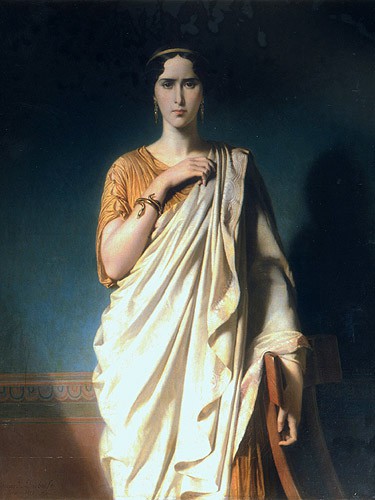Of all the legendary figures of French theatre, Rachel remains one of the most fascinating. Born in poverty in 1821, the daughter of Alsatian jewish pedlars, little Elisa Félix, not yet 17, made her debut in 1838 under the name of Rachel, and her career was to bring her the greatest success. Indeed, she was to be recognised as the greatest tragedian of the 19th century. And as a French citizen of the second generation of Jews after the Emancipation, she was so remarkable a model of integration that she was to become the personification of the Republic and the Nation during the Revolution of 1848 as a result of her intepretation of “La Marseillaise”. An international star in the modern sense of the term, she was an icon who wove her spell on the masses, and was to be worshipped by her public, even before her death in 1858 of tuberculosis.
It was in the role in which she made her debut, and in which she triumphed on the stage of the Théâtre Français, that of Camille in Corneille's “Horace”, which the fashionable Second-Empire portrait painter, Edouard-Louis Dubufe, chose to paint her in 1850. Well aware of the power of images, Rachel worked with many artists, and her image appeared in numerous paintings, drawings, lithographs, photographs and mass-produced sculptures, not counting the more traditional media of the press and caricatures. Set in the severe pose of an antique statue, Rachel is presented here by Dubufe as the actor through whom classical tragedy was to experience its renaissance. Indeed, the identification of Rachel with this renaissance was to become complete when she played Phèdre in 1843. In the eyes of the world she was Melpomene, the muse of Tragedy, and this was how she was to be painted by Amaury Duval in 1851, and later Gérôme in 1859.
A 'femme libre' with a tumultuous private life, Rachel chose her lovers from amongst the highest in political life, notably: the Prince de Joinville, son of Louis-Philippe; the Prince Louis-Napoléon, future Napoleon III (for whom in 1852 she declaimed Arsène Houssaye's verses, “L'Empire, c'est la paix”); Napoleon III's cousin, the Prince Napoléon, with whom she was to remain firm friends; but also and primarily, the Comte Alexandre Walewski, son of Napoleon and Marie Walewska, with whom she lived from 1843 to 1846. From this passionate relationship a son was to be born in 1844, Alexandre, whom Walewski recognised as his own and who was to be raised with the children of the Comte's second marriage on Rachel's death.
Karine Huguenaud (tr. P.H.)
April 2004
Madame R. or Rachel in the role of Camille
Artist(s) : DUBUFE Edouard-Louis

- Date :
- 1850 (Salon of 1852)
- Technique :
- oil on canvas
- Dimensions :
- H = 1.27 m, L = 1.01 m
- Place held :
- Collections of the Comédie-Française
- Photo credit :
- © Collections de la Comédie-Française - J-L Charmet

